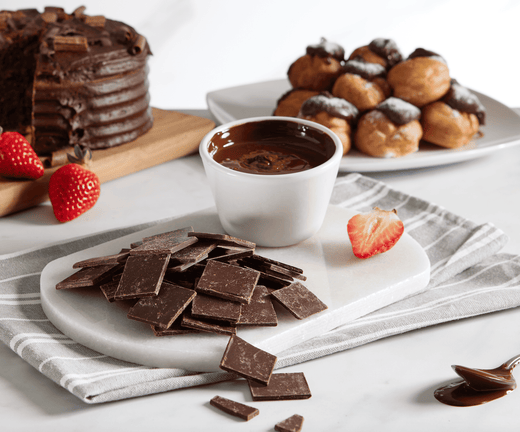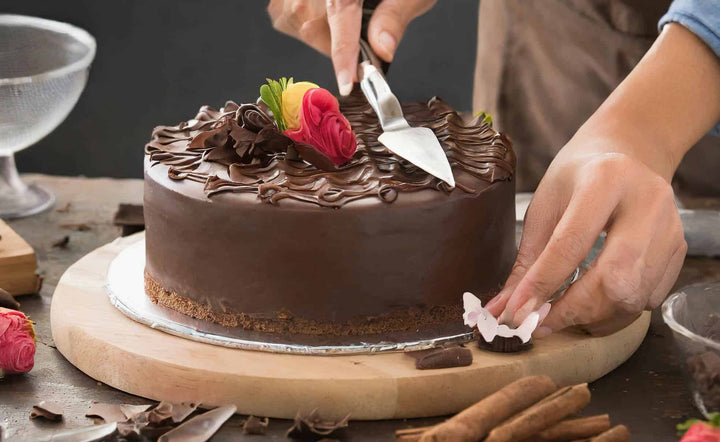There is nothing quite like the delicious taste of melted chocolate to enhance your cakes, biscuits, or even to dip some strawberries in.
But have you ever found your chocolate too thick and unmanageable when you've melted it down?
Overly thick chocolate that refuses to coat your favourite treats smoothly is a common baking dilemma.
In this post, we will explore a few handy tips and tricks for thinning out melted chocolate and ensuring it maintains that lovely, pourable consistency.
Whether you're making a chocolate fountain for your garden party or simply want a thin layer of chocolate on your homemade flapjacks, these tips will solve your problem.
Related: How to Make Chocolate Shards.
How to Thin Melted Chocolate
To thin melted chocolate, add a small amount of neutral oil, like vegetable oil or cocoa butter, stirring gently until it reaches the desired consistency.
Melt slowly to avoid overheating, and keep water out to prevent the chocolate from seizing.

How to Melt Chocolate So It Stays Thin
-
Choose your chocolate: Opt for high-quality chocolate specially created for melting and baking.
-
Chop the chocolate: Chop the chocolate into small, uniform pieces. This helps the chocolate to melt evenly, preventing lumps and thick patches.
-
Melt the chocolate: There are two common methods for melting chocolate: the double boiler method and the microwave method. For the double boiler, fill a saucepan with a bit of water and heat it until it simmers. Place a heatproof bowl on top of the saucepan, ensuring the bottom of the bowl doesn't touch the water. Add the chocolate to the bowl, stirring frequently until it's completely melted. For the microwave method, place your chocolate in a microwave-safe bowl, heat in 30-second bursts, stirring after each until the chocolate is melted.
-
Thin the chocolate: Once your chocolate is melted, it's time to thin it out. The most popular method is to add a bit of fat to the chocolate. The fat you use should be flavourless to avoid altering the taste of your chocolate. Cocoa butter is the best option as it's the natural fat in chocolate. Alternatively, you can use a bit of vegetable oil or shortening. Start by adding just a small amount (a teaspoon for every 100 grams of chocolate should suffice), stir it in, and see if the chocolate is thin enough for your needs. If not, add a little more, but remember - it's easier to add than to take away!
-
Stir gently: It's crucial to stir your melted chocolate gently after adding your chosen fat. Vigorous stirring can incorporate too much air into the chocolate and cause it to become thick and lumpy.
-
Test the consistency: Dip a spoon or a piece of fruit into the chocolate. It should coat the item thinly and evenly. If it's still too thick, add a touch more of your chosen fat and stir gently.
Remember, practice makes perfect when it comes to melting and thinning chocolate.
With these steps, you will have beautifully thin, pourable chocolate that's perfect for all your baking and decorating creations.
Happy chocolate making!
(Before you read on, you might also like to read this post asking: What is Bittersweet Chocolate?)

What Does Thinning Chocolate Mean?
Thinning chocolate is a technique used in baking and confectionery to adjust the viscosity, or thickness, of melted chocolate.
When you melt chocolate, it can sometimes be too thick to use effectively for specific tasks, such as coating biscuits, drizzling over cakes, or filling a chocolate fountain.
In simple terms, to 'thin' chocolate means to make it more fluid or runnier.
This is usually achieved by adding a small amount of fat – typically flavourless – to the melted chocolate.
Common types of fat used for thinning chocolate include cocoa butter, vegetable oil, or shortening.
By mastering the art of thinning chocolate, you'll be able to achieve a smooth, glossy finish on your homemade treats and enhance the ease of working with chocolate in your kitchen.
(Take a look at this post if you would like to read about: How to Tell if Chocolate Has Gone Bad).
What Ingredients Can You Use to Thin Out Chocolate?
When it comes to thinning out chocolate, there are a few ingredients that can be employed to achieve that desired smooth and pourable consistency.
Here are a few options:
-
Cocoa Butter: This is the preferred choice for thinning chocolate. Being a fat naturally found in cocoa beans, cocoa butter will preserve the flavour and texture of the chocolate. However, it can be a bit more expensive and harder to find than other options.
-
Vegetable Oil or Canola Oil: A few drops of a neutral, flavourless oil can help to thin out your chocolate. Be cautious when using oil, as adding too much can make the chocolate oily.
-
Shortening: A little shortening mixed in with your chocolate can also make it thinner. Similar to oil, add it sparingly to avoid affecting the taste and texture of your chocolate.
-
Coconut Oil: While coconut oil can impart a slight coconut flavour, it can be a good option for thinning chocolate, especially if you like the taste of coconut.
-
Butter: This can be used, but it's not the ideal choice. Butter contains water, which can cause your chocolate to seize and become lumpy. However, in a pinch, a small amount could be used.
-
Cream or Milk: These can be used to create a chocolate ganache, which is a mixture of chocolate and cream. This will result in a thinner, smoother chocolate mixture, but it will also change the flavour profile, making it creamier and softer.
Remember, the key to thinning chocolate is to add your chosen ingredient little by little, stirring gently until you achieve the desired consistency.
Too much of any ingredient can ruin the taste and texture of the chocolate, so be patient and add sparingly.
How to Avoid Thick Chocolate When Melting It
To avoid ending up with thick, gloopy chocolate when melting it, follow these tips:
-
Chop the chocolate: Before melting, chop your chocolate into small, uniform pieces. This allows it to melt evenly, which helps prevent clumps and thick spots
-
Use high-quality chocolate: Opt for high-quality chocolate specially created for melting and baking.
-
Avoid water contact: Water is the enemy of melting chocolate. Even a small amount can cause chocolate to seize up and become grainy and thick. Ensure your utensils are completely dry, and avoid using a lid when melting chocolate, as it can cause condensation to drip into the chocolate.
-
Don't overheat: Overheating can cause chocolate to become thick and grainy. Chocolate melts at a relatively low temperature (around 32-45°C, depending on the type of chocolate). If using a microwave, it's better to stop when most, but not all, of the chocolate is melted. Simply stir until the remaining lumps have melted in the residual heat.
-
Consider an emulsifier: If you're still struggling with thick chocolate, you can add an emulsifier, such as lecithin found in many vegetable oils, to help maintain a smooth and fluid consistency.
By following these steps, you should be able to melt chocolate smoothly without it becoming overly thick.
(Take a look at this post for some ideas for: What To Do With Leftover Melted Chocolate?)
Can You Thin Chocolate With Milk?
While it might seem logical to thin out chocolate with milk, given its liquid properties, it's generally not the best idea for pure melted chocolate.
Chocolate is made up of particles (like cocoa and sugar) suspended in fat (usually cocoa butter).
Introducing water or water-based liquids such as milk into this can disrupt the fat's ability to keep those particles suspended.
This can cause the chocolate to 'seize', turning it from a smooth liquid into a grainy, clumpy, and thick mess.
However, if you're aiming to create a creamy chocolate sauce, ganache, or chocolate fondue, you can indeed use milk, cream, or even a dairy-free alternative.
This would be a different application than simply trying to thin out chocolate for coating or decorating, as it results in a different flavour and consistency.
When making a chocolate ganache, for example, heat the cream or milk first and then add the chocolate pieces, stirring until you achieve a smooth and creamy texture.
The ratio of cream or milk to chocolate will determine the thickness of the mixture, so adjust according to your specific recipe or preference.
Remember, as with all cooking and baking endeavours.
The key is often practice, patience, and a bit of trial and error. Enjoy the process and happy chocolate making!
Some Tips From an Expert Chocolatier
Then explain that you used the Whiaker's in-house expertise to create chocolate that melts perfectly and then link to the Easy Melts.
As an expert chocolatier at Whitakers Chocolates, I have the privilege of immersing myself in the indulgent world of chocolate every day.
Part of the Whitaker family, the creation and enjoyment of quality chocolate is more than just my occupation - it's a deeply-rooted tradition and a significant part of our family's heritage.
From selecting the highest quality ingredients to meticulously crafting our chocolate recipes, the world of chocolate-making is a part of the very fabric of my existence.
Now, melting chocolate may seem like a simple task to some, but as any seasoned chocolatier will tell you, achieving that perfect, smooth consistency is a true art form, requiring a balance of time, temperature, and technique.
Here at Whitakers, we've spent years honing our skills and mastering the craft of chocolate-making.
Recognising the challenges many face when attempting to melt chocolate at home, we decided to share our expertise in a very special way.
We set out to create a product that encapsulates our in-house knowledge and offers a hassle-free solution to our customers. And so, Easymelt was born.
Easymelt is a couverture dark chocolate - a term that signifies 'high quality' in the chocolate world.
Our Easymelt chocolate boasts a minimum of 55% cocoa solids, ensuring a rich, deep flavour that true chocolate connoisseurs will appreciate.
Designed to melt smoothly and effortlessly, Easymelt takes the guesswork out of the melting process.
Ideal for moulding, decorating, flavouring, or even dipping your favourite fruits or treats, it provides a versatile base for your culinary creations.
We're incredibly proud of Easymelt, not only for its superior quality but also for the way it embodies the Whitaker family's dedication to sharing the joy of chocolate-making.
With Easymelt, we've done the hard work for you - so all you need to do is enjoy the delicious possibilities it brings to your kitchen.
Click here to buy our Easymelt Chocolates.
Final Notes On How to Make Melted Chocolate Thinner
Thinning chocolate is a common task when crafting various chocolate treats and can be achieved using careful techniques and specific ingredients.
The quality of your chocolate is crucial, with high-cocoa butter content chocolate offering superior taste and texture when melted.
Keeping water or moisture from infiltrating the melting process is vital to prevent the chocolate from seizing up and becoming granulated.
Gently melting the chocolate, whether through a microwave or double boiler, helps to evade overheating and keeps the texture smooth.
To further thin the chocolate, a small amount of neutral oil or fat, such as cocoa butter, vegetable oil, or shortening, can be added cautiously to avoid altering the taste or making the chocolate overly oily.
Finally, it's important to remember that each type of chocolate may react differently when melted and thinned, so some experimentation may be needed to achieve optimal results.
With patience and practice, even novice chocolate enthusiasts can master the process of thinning chocolate.
And remember, if you'd rather bypass the guesswork and ensure perfect results every time, our Whitakers Easymelt chocolate is always there to help make your chocolate creations as easy and delicious as possible.
Enjoy your chocolate journey and happy baking!











